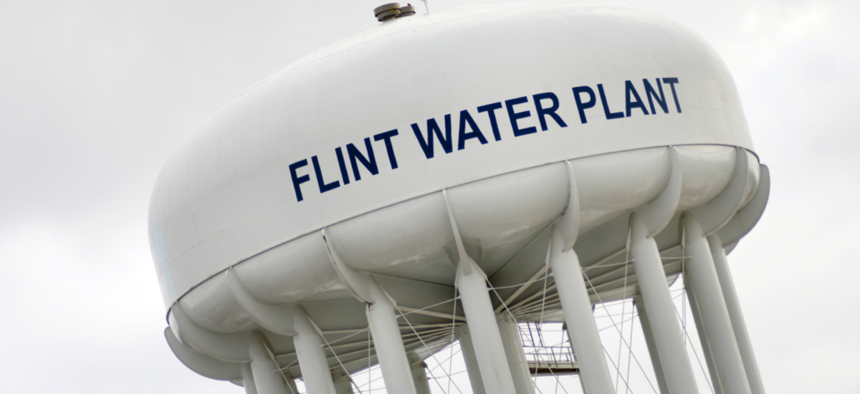Seeking Solutions for the ‘Water Infrastructure Death Spiral’

Shutterstock

Connecting state and local government leaders
It’s a problem communities can face when populations and property values decline.
WASHINGTON — Cities with shrinking populations and aging water infrastructure can face tough choices when it comes to paying for waterworks upgrades and keeping service affordable.
This has some experts and lawmakers raising concerns. They caution that there are localities around the U.S. that could be at risk of problems similar to those that bedeviled Flint, Michigan, where residents were exposed to lead-contaminated drinking water.
“Communities that are struggling begin to make sacrifices, budgetary decisions, based on what they can afford and what their immediate needs are,” Rep. Dan Kildee, a Michigan Democrat whose district encompasses Flint, said at an event on Capitol Hill on Wednesday.
“Services like police and fire, and taking care of parks and managing streets, the things that people see, end up getting attention and the unseen infrastructure is allowed to continue to atrophy,” he added.
Kildee made his remarks during the latest in an ongoing series of forums he has hosted to foster discussion about the future of America’s cities and towns. Wednesday’s roundtable focused specifically on investing in the nation’s water infrastructure.
Rep. Elizabeth Esty, a Connecticut Democrat, also took part in the event.
Marc Edwards, an engineering professor at Virginia Tech who helped uncover the contamination in Flint’s water, said that the federal Safe Drinking Water Act has become a “charade.” He pointed to several examples of places struggling with subpar water systems.
Too many communities, according to Edwards, are confronted with a dilemma: they cannot afford to meet federal standards, or to upgrade antiquated infrastructure.
“Many feel forced to cut corners, or cheat outright, and tell their residents that their water is safe when it simply is not,” he said. “Our regulators are placed in an equally impossible situation, because their options are either to look the other way, or impose fines and turn off the water, which would make a bad situation even worse.”
“The very worst of these problems, they’re triggered by declining populations and property values,” Edwards added. Water systems, he explained, become more trouble-prone and more expensive for ratepayers to support, as the number of users goes down. “Flint was ahead of the curve, really, in experiencing the water infrastructure death spiral that results.”
Michele Nellenbach, director of strategic initiatives at the Bipartisan Policy Center, also took part in Wednesday’s roundtable discussion. Affordability, she said, is one of the “major issues that local governments come up against if they try to increase rates.”
Nellenbach highlighted guidelines that define “affordable” water as costing no more than 2.5 percent of annual household income. But, she said, in some places rates push that figure upwards of 4 percent.
“How do you deal with that?” she said. Part of the solution, Nellenbach suggested, is charging rates that reflect the true cost of service, while also offering low-income assistance programs.
Brian Pallasch, managing director of infrastructure initiatives for the American Society of Civil Engineers, lauded the effectiveness of state revolving funds, or SRFs, which are federally supported and provide low-cost financing for water and sewer projects.
“But there’s not enough money,” he said.
Kildee noted that cheap financing is not a cure-all for rebuilding waterworks in some financially stressed cities.
“In Flint,” he said, “if we could get zero-percent loans for a hundred years, we still couldn’t pay it.” That’s because residents there, according to Kildee, would not be able to afford the increased water rates required to repay the borrowed money.
Moody’s Investors Service issued a report this week that said the median remaining useful life of water and sewer systems in the U.S. will decline to 28.2 years by 2018, if current trends continue. That’s a roughly two-year decline compared to 2012.
“It is imperative that annual capital expenditures provide for regularly scheduled maintenance to ensure large scale bonded projects do not balloon,” the Moody’s report added.
But, according to Edwards, for places with failing water systems, dwindling populations and economic difficulties, there isn’t yet a proven solution for how to upgrade infrastructure, while maintaining affordable rates. Even after millions of dollars are spent in the coming years to replace Flint’s water lines, he said, there’s another problem the city will be dealing with.
“That does nothing to reduce the high water rates,” he said. “They’re paying amongst the highest water rates in the world,” the professor added, “for water that they justifiably will never have trust in again.”
Bill Lucia is a Senior Reporter for Government Executive’s Route Fifty and is based in Washington, D.C.

NEXT STORY: D.C. Has to Work Around a White House That Denies Climate Change to Prepare for a 500-Year Flood





